
| Workshop | Empennage | Wings | Fuselage | Contact |
Tail Cone Construction
Part 3 of 3
(see also part 1 and part 2)
20 Jun 2010
Big day today! Finally had a full day in town to knock out the remaining Alumiprep, Alodine, and Akzo work that needed to be done. Spent about 12 hours today taking care of that.
This was the first time that I needed to treat a part with Alodine that was too wide for my long thin dunk tanks. I purchased three 36" x 18" plastic bins from WalMart and used these as dunk tanks as well. The F-1007 frame halves and aft deck were still a bit too large to fit into the liquid all at once, but I was able to rotate them through to get full coverage. In the photo below, you can see one corner of the aft deck sticking out of the Alumiprep.

Other than that, everything went as usual in ChemistryLand. One small change from previous priming tasks was the need to prime strips on the outer face of some skin pieces which will eventually be overlapped by some other skin part. I taped down a strip of 18" masking paper to prevent overspray, then just primed the overlap strips like anything else:
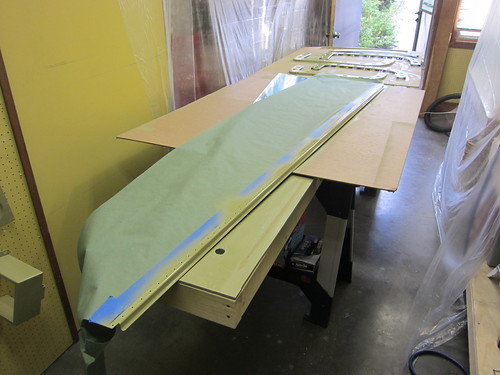
The pieces that need it are both edges of the bottom face of the bottom skin, both top edges of the side skins (I accidentally did the bottom edges as well), and the forward edge of the aft top skin.
I got a bit ahead of myself on calling it quits with the priming. I looked at this wall of done parts, didn't see anything else that needed to be done, and cleaned all my gear.
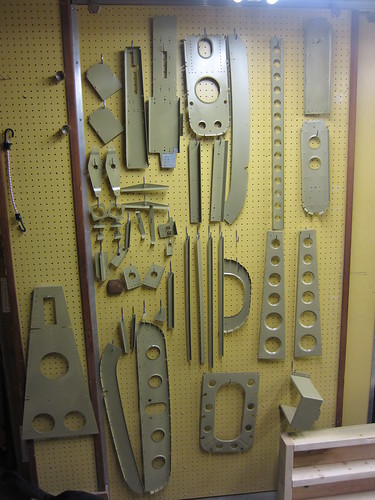
Unfortunately, there was still a small pile of small parts on the shelves behind this sliding wall which I didn't realize until the shop was cleaned, the painters tarps had been pulled down, and the excess primer had already been dumped. Boo. I'll have to finish off the primer tomorrow.
I wanted to do some riveting, but the very first riveting step (the elevator bellcrank assembly) needed parts that weren't primed yet. So I skipped ahead a bit and did what I could. I started with the battery tray. As per the instructions, I added a bunch of nutplates. I also riveted on the custom grounding plate (I had masked off the contact area so that neither piece had primer there).

The battery tray includes two custom nutplates for my battery box and is missing the two nutplates for the stock hold-down bolts (which I will not be using).
Did a bit of work on the aft two bulkheads, doing what I could without the unprimed parts. Got the lower stiffener and a wire tie anchor for the rudder wiring bundle installed in the F-1010 bulkhead:

I also got the F-1011 and F-1012 bulkheads and the tie-down block riveted together:

That's where I called it a night. Hopefully soon I'll get the rest of the small parts primed so that the riveting work can begin in earnest.
22 Jun 2010
Yesterday after work I finished of a quick batch of priming for those small parts I forgot to do on Sunday. Then I set about with the riveting. Got the elevator bellcrank done and bolted the bellcrank assembly down to the battery tray and marked all of the bolts with torque seal. I did all of the riveting on the elevator trim bracket, but ran into problems of missing cotter pins and a tight bellcrank when assembling the mechanical pieces. I'll come back to this later.
Then I finished off the F-1012 and F-1011 bulkheads that I had started last time, since their missing small parts were now primed and ready to install. I also finished the F-1010 bulkhead and added its two lightening hole wire tie anchors. The lower one marks the aft end of the bottom tail cone conduit run, and the upper one is where the VS cable bundle and elevator trim cable bundles will pass through on their way down to the conduit.

I then took care of the F-1007 and F-1008 frames and their conduit anchors as well. I pop riveted the threaded inserts into the ends of the pushrod and threaded the bearings into the ends, rendering this subassembly complete.
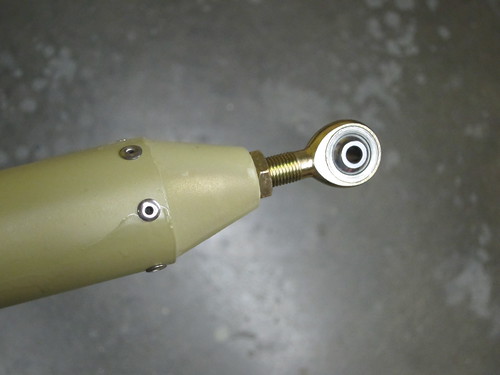
Tonight, I started by back-riveting in the doubler for the NAV antenna beneath the horizontal stabilizer. I won't be populating this antenna initially, so this is just a stand-in for later (hence the tiny central guide hole).
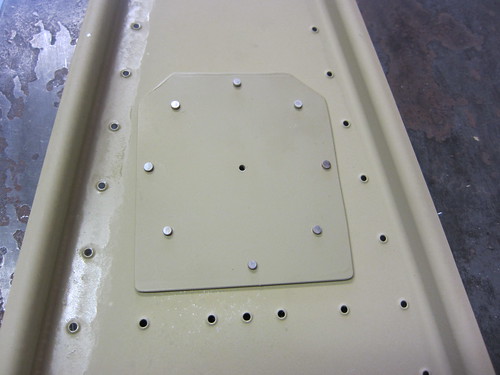
Next I added the elevator horn access panel nut plates and the rudder stop skin stiffener to the aft end of the left-side skin. The nutplates were squeezed and the stiffener was back-riveted.

I'm trying to back-rivet as much as I can on the tail cone because a) I can do it myself and b) it is much less error-prone than using the bucking bar. As such, there will be some slight departures from the plans in terms of riveting order in order to maximize the amount of the piece that I can back-rivet.
I re-assembled the entire tail cone minus the right skin and top-side bits, making sure to put all of the clecos on the left and bottom skins on the inside of the piece. This allows me to lay the tail cone on its bottom or left sides on carpet strips on top of my workbenches and have a small section exposed to the back rivet plate. I should be able to get pretty much all of the skin holes with the back rivet set this way. Once the bottom and left side are done, I'll put the right side skin on and do it up.
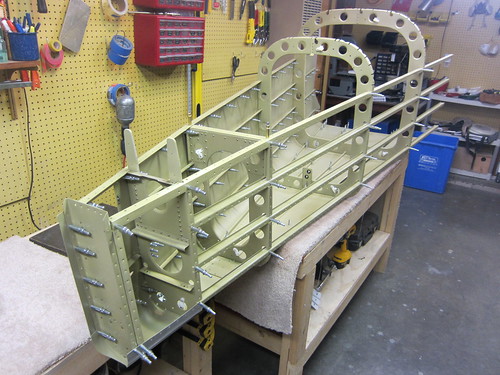
As I go I'll try to point out here anywhere where I'm not able to use the back rivet set (or the squeezer); I'm guessing it will be a significant minority of the rivets.
27 Jun 2010
Did a lot of work this weekend getting rivets banged out on the tail cone. I'm still working on the skin stiffeners, most of which can be back-riveted, but I'm almost done. Both -F and the -G stiffeners on the bottom skin are done. The -C, -D, and -E stiffeners on the left side are done—I did these with the right-side skin off so that I could reach the aft-most rivets with my rivet gun. The only ones I couldn't do with the back rivet set were the rivets immediately aft of the F-1010 bulkhead, which the standard back-rivet set couldn't reach becaues the bulkhead interfered.
While the right-side skin was still off, I went ahead and squeezed the two AN470 rivets that attach the left-side rudder stop skin stiffener to the rudder stop itself. These are in a really tight space and it will be a pain to get the other two once both skins are in place. But half the pain-in-the-butt work is a win in my book.
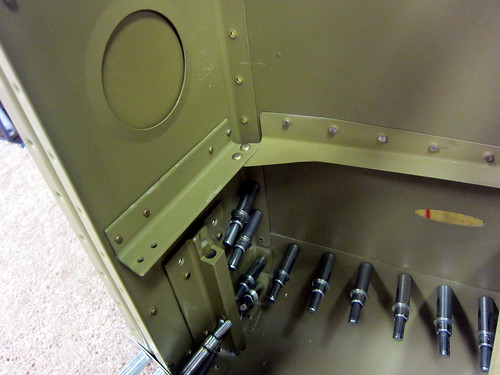
With that, I hauled the second skin piece out of the garage and attached its rudder stop skin stiffener and the four nutplates for the access plate. The nutplate rivets were all squeezed; the stiffener was back-riveted.
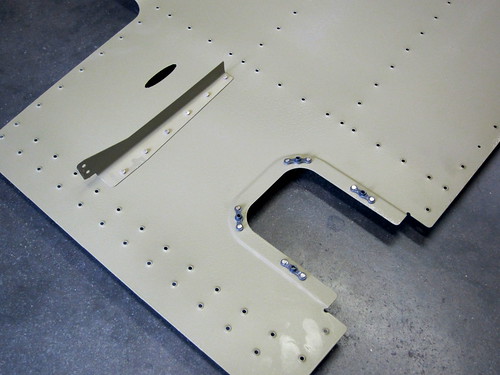
After clecoing the right-side skin onto the existing frame, I started on back-riveting the stiffener rivets on this side. Got two of the three done before calling it a night tonight. It's slow going doing this in sets of 10 rivets at a time by myself, but the finish quality is excellent. I did manage to get one small smiley in the left skin, but it is tucked up under the horizontal stabilizer where I won't have to look at it much. (I got it when I tried bucking one of the un-back-rivetable rivets myself, of course)
The key for me here was making sure that the piece was sitting flat on the riveting plate. I screwed this up several times, resulting in groups of 2-7 rivets that were proud and had to be drilled out and replaced with oops rivets. By the time I got to the right side, however, I seem to have figured it out. I'd estimate there are probably 20 oops rivets on the left side skin (so far!), whereas in the two stiffeners I've done on the right side so far, there is only one oops rivet.
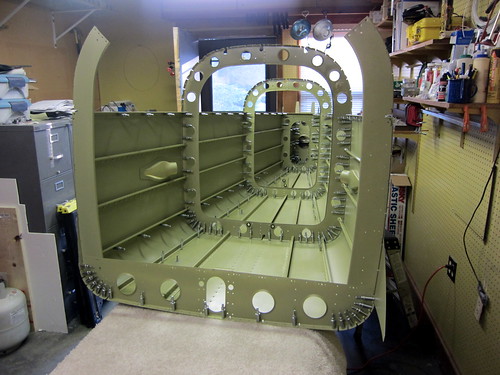
One more stiffener on the right side to do, then I start work on the frames and bulkheads. I'll start at the big end, working down from the top as the plans recommend. I'll need bucking assistance for the F-1011 and F-1012 bulkheads. I imagine I can get to that point in one more long evening of riveting, if one presents itself.
6 Jul 2010
The riveting of the tail cone continues. I got as far as I could with back riveting and have now transitioned into bucking the rivets that can't be reached with the back rivet set.

Not much to see in the way of pictures... there's just less and less clecos everyday. I did take a break from skin rivets for awhile and put the elevator bellcrank ribs together
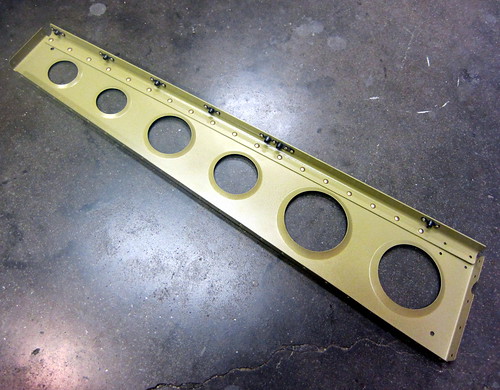
In this shot you can see the extra nutplate I added to the right-side rib for the aft-right corner of the battery box.
Not much left on the lower-half of the tail cone in the way of rivets... I figure one more good evening of it and it'll be done. Got all of the bulkhead and frame rivets complete as well as all of the stiffeners. Also did one of the two side/bottom skin joints.
15 Jul 2010
Jeremy and I did one more evening of riveting to knock out the remaining skin rivets. This included attaching the elevator bellcrank ribs. However, before attaching these two parts, I added a last-minute customization. I was thinking that it might be good to have an easy way to route cables, tubes, etc. from one side of the tail cone to the other in a tidy manner. My solution was to pass them through the aft-most lightening holes in the bellcrank ribs. This area is essentially unused space and does not interfere with the bellcrank mecahanism.
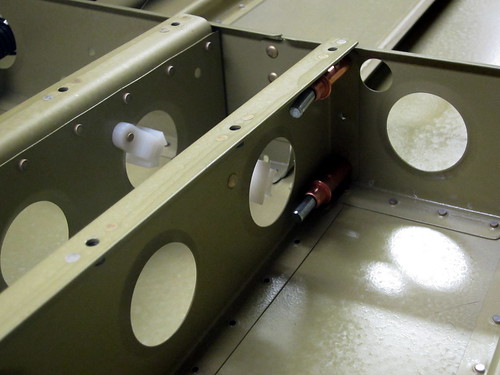
I added a lightening hole wire tie anchor to each of the holes in such a position that it wouldn't get in the way when doing the rivets that attach the aft flange of the rib to the F-1007 frame. Now, if I have something that needs to be routed from one side to the other, I can just pass it through here and fasten it to the anchors. Piece of cake.
With all of the principal riveting done before moving on to the aft deck, I decided to finish up a bit of accessory work. I started with the static air system. Because I'm going to route my static air lines up the aft face of the F-1008 frame, I can go ahead and put in the hardware to secure it since the aft face doesn't get in the way of the frame/skin rivets.
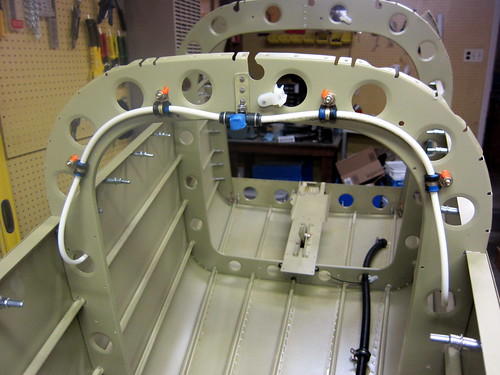
The static air ports have 90° fittings on them which face aft. The white air tubing leaves these fittings and passes immediately through a lightening hole in the F-1008 such that no hardware is required to keep the tubing from touching the hole edges. From there, the tube curves around and passes along the aft face of the frame until it meets the T-connector that I installed earlier. A pair of adel clamps (-04 size) keeps the tubing in place on each side. I hit the bolts with inspection lacquer just to be safe. Here's another view of the air line leaving the right angle fitting and heading through the lightening hole:

Next, I installed most of the bottom conduit that runs from just aft of the F-1006 bulkhead to just aft of the F-1010 bulkhead. This included three Click Bond threaded stand-offs with adel clamps (-12 size) and three lightening hole wire tie anchors with wire ties and RTV.
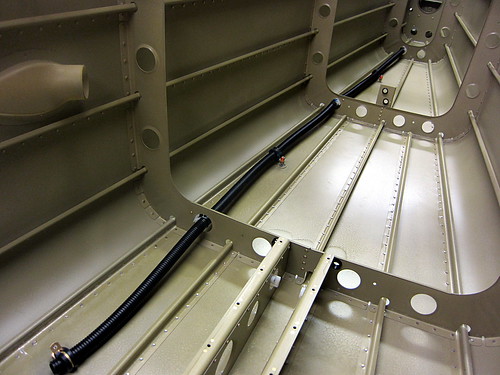
Here's a closeup of the hardware I used on the Click Bond studs:

I made an elevated "platform" out of two nuts with a lock washer inbetween. Then the adel clamp, a plain washer, and an elastic stop nut on top. This keeps the conduit from ever touching the skin of the plane. The conduit will hopefully be large enough to hold the NAV1 antenna cable, tail light wires, rudder trim wires, elevator trim wires, and vertical stabilizer tip fairing accessory wires.
With this done, it was time to get started on the aft deck. I've been crazy busy at work lately so work has come in small chunks here and there, but I did manage to get a friend from work to come down and help me replace the bad rivets I had identified in the skins and then do all of the rivets connecting the aft deck to the longerons, up elevator stop, and F-1009 frame.
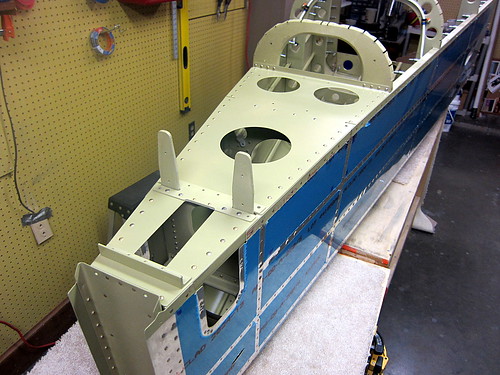
Just a couple more to do and it's time to start adding the bolts in this region. This means that it is almost time to button up the top of the tail cone, which will entail moving my primary work space into the garage!
17 July 2010
Jeremy and I made quick work of the remaining rivets in the aft deck, and I added the eight bolts in that area. They were torqued to 25 inch-pounds and marked with inspection lacquer.

With the aft deck work complete, the next step is to add the top stiffeners and skin. However, this makes the tail cone too large to fit out the door. So with that, it was time to re-locate to the garage!
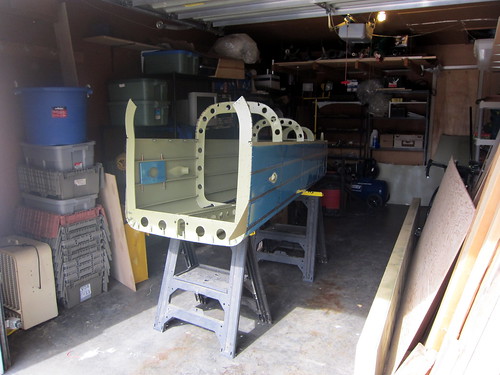
I quickly back-riveted the ELT antenna doubler on to the underside of the aft top skin, placed the A and B stiffeners onto the tail cone, then cleco'd the skin to the stiffeners and frames. I took a cue from Mark and Angela Lanier's project and only cleco'd on the horizontal top bits and let the skin stick striaght off to the sides. This allows my rivet bucker to access the underside of the top rivets without having to crawl inside.
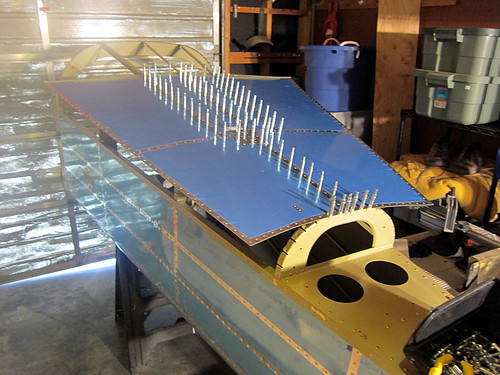
Jeremy and I made quick work of these rivets last night and this morning. From there, we bent one side down and cleco'd it in place, but left the other hanging. That way, we were able to do the entire left side without having to crawl inside. Having completed that and then bent and cleco'd the other side in place, the result looks like this:
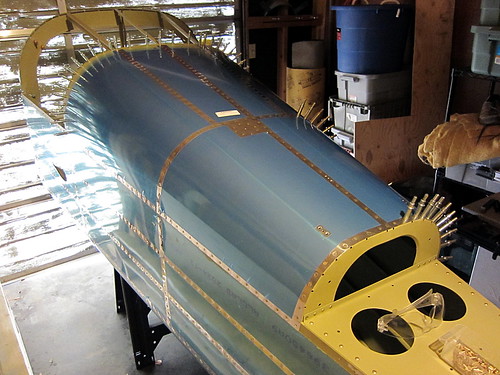
By reaching in through the F-1009 hole (the D-shaped hole, above), we should be able to buck all of the rivets that attach the skin to the F-1009 frame, as well as the aft-most holes in the longeron. By reaching around past the front end of the skin, we should be able to do a bunch of the forward-most rivets in the longeron as well. This leaves only the curved portion on the right side of the F-1008 frame and a bit of the longeron that will need to be done from inside. First, I need to get some styrofoam cut up to make a platform so that Jeremy doesn't bend up the fragile bits inside the tail cone.
Today, somewhere along the left longeron of the tail cone, we put the 5000th rivet into the plane!
22 Jul 2010
I was originally thinking that we would buck the reachable rivets on the tail cone prior to having Jeremy crawling inside to get the unreachable ones. But after discussing it, we decided that he could do a better job from inside and there weren't all that many anyway. So I built up a platform of foam and blankets so that he wouldn't bend anything in there. I used some of the styrofoam that the came as packing material inside the empennage shipping crate for the base layer.
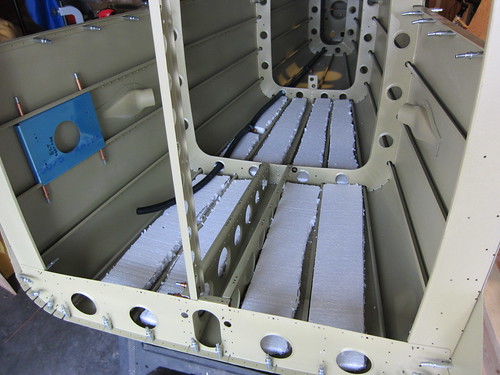
It was about an inch thick and this was high enough to get above the stiffeners. Above these pieces, I cut out some 2" pink foam blocks using a sawzall and this got the platform up above the level of the frame bottoms. On top of that I just layed a blanket down and that seemed to be enough. I'll save the foam pieces for any future need to get inside the tail cone.
Anyway, here's the requisite RV-10 construction photo of some poor sap squished inside the aft end of the tail cone:
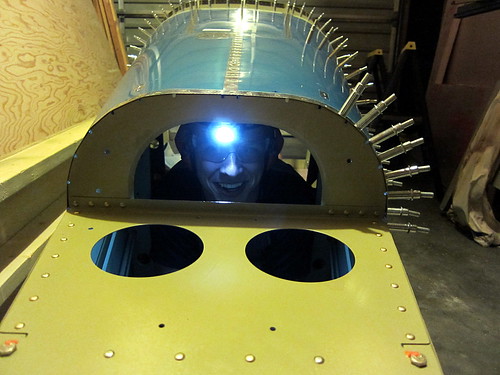
We made quick work of the remaining 50 rivets and I think he was thankful to be out of there.
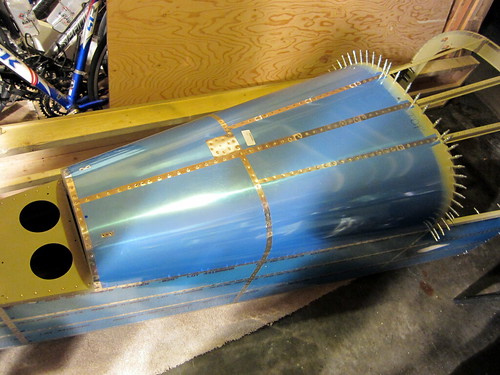
At that point, the rivets on the tail cone were essentially done (for now). The forward skin doesn't go on until the tail cone gets attached to the fuselage, and that's years away. So I turned my attention from rivets to the remaining internal accessories.
First up was the upper conduit. This conduit's aft terminus is at the F-1008 frame next to the static air T junction. I used the lightening hole wire tie anchor that I had riveted in earlier to wire tie the conduit in place. I hit it with a dab of black RTV to keep it all rigid.
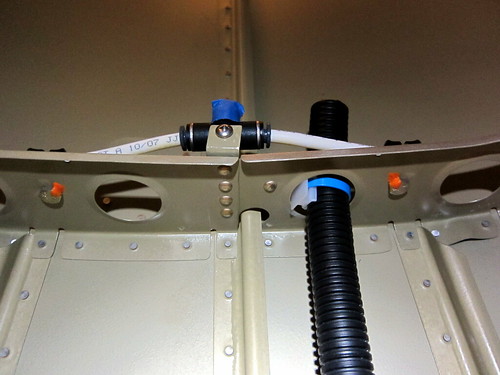
The treatment at the F-1007 frame was essentially the same. Half way between the two frames I pop-riveted in the custom drop bracket I had fabricated earlier. From there, I attached an adel clamp to support the conduit. I used brass hardware because this adel clamp is right above where the magnetometers will eventually sit.
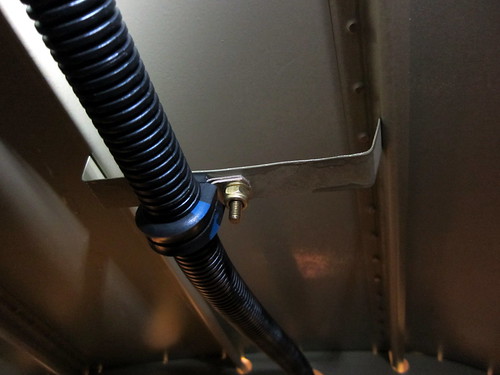
Forward of the F-1007 frame, the conduit remains incomplete since its drop bracket will get in the way of riveting on the forward ends of the A and B stiffeners under the forward top skin.
The second task to take care of was the rails for the magnetometer shelf. These were just a pair of angle aluminum bars that I had fabricated and primer earlier. I attached them to the bottom side of the longeron roughly half-way between the F-1007 and F-1008 frames and about 10 cm apart from each other. The attachment hardware was again all brass to keep any ferrous metal as far away from the magnetometers as possible.
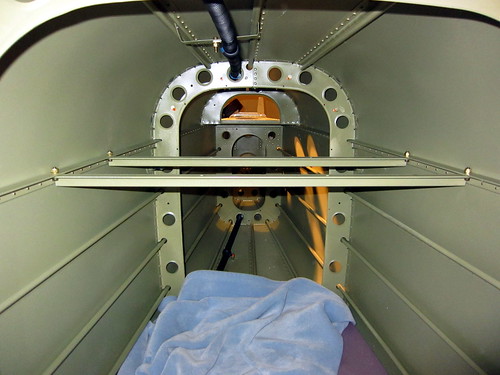
The magnetometer platform that sits atop these rails will be fabricated later, when I know more about what the mounting requirements of the magnetometers are. So for now, this bit is done. In fact, this is the end of the tail cone chapter of the plans! Time to move on to the empennage attach chapter.
20 Jun 2010
Big day today! Finally had a full day in town to knock out the remaining Alumiprep, Alodine, and Akzo work that needed to be done. Spent about 12 hours today taking care of that.
This was the first time that I needed to treat a part with Alodine that was too wide for my long thin dunk tanks. I purchased three 36" x 18" plastic bins from WalMart and used these as dunk tanks as well. The F-1007 frame halves and aft deck were still a bit too large to fit into the liquid all at once, but I was able to rotate them through to get full coverage. In the photo below, you can see one corner of the aft deck sticking out of the Alumiprep.

Other than that, everything went as usual in ChemistryLand. One small change from previous priming tasks was the need to prime strips on the outer face of some skin pieces which will eventually be overlapped by some other skin part. I taped down a strip of 18" masking paper to prevent overspray, then just primed the overlap strips like anything else:

The pieces that need it are both edges of the bottom face of the bottom skin, both top edges of the side skins (I accidentally did the bottom edges as well), and the forward edge of the aft top skin.
I got a bit ahead of myself on calling it quits with the priming. I looked at this wall of done parts, didn't see anything else that needed to be done, and cleaned all my gear.

Unfortunately, there was still a small pile of small parts on the shelves behind this sliding wall which I didn't realize until the shop was cleaned, the painters tarps had been pulled down, and the excess primer had already been dumped. Boo. I'll have to finish off the primer tomorrow.
I wanted to do some riveting, but the very first riveting step (the elevator bellcrank assembly) needed parts that weren't primed yet. So I skipped ahead a bit and did what I could. I started with the battery tray. As per the instructions, I added a bunch of nutplates. I also riveted on the custom grounding plate (I had masked off the contact area so that neither piece had primer there).

The battery tray includes two custom nutplates for my battery box and is missing the two nutplates for the stock hold-down bolts (which I will not be using).
Did a bit of work on the aft two bulkheads, doing what I could without the unprimed parts. Got the lower stiffener and a wire tie anchor for the rudder wiring bundle installed in the F-1010 bulkhead:

I also got the F-1011 and F-1012 bulkheads and the tie-down block riveted together:

That's where I called it a night. Hopefully soon I'll get the rest of the small parts primed so that the riveting work can begin in earnest.
22 Jun 2010
Yesterday after work I finished of a quick batch of priming for those small parts I forgot to do on Sunday. Then I set about with the riveting. Got the elevator bellcrank done and bolted the bellcrank assembly down to the battery tray and marked all of the bolts with torque seal. I did all of the riveting on the elevator trim bracket, but ran into problems of missing cotter pins and a tight bellcrank when assembling the mechanical pieces. I'll come back to this later.
Then I finished off the F-1012 and F-1011 bulkheads that I had started last time, since their missing small parts were now primed and ready to install. I also finished the F-1010 bulkhead and added its two lightening hole wire tie anchors. The lower one marks the aft end of the bottom tail cone conduit run, and the upper one is where the VS cable bundle and elevator trim cable bundles will pass through on their way down to the conduit.

I then took care of the F-1007 and F-1008 frames and their conduit anchors as well. I pop riveted the threaded inserts into the ends of the pushrod and threaded the bearings into the ends, rendering this subassembly complete.

Tonight, I started by back-riveting in the doubler for the NAV antenna beneath the horizontal stabilizer. I won't be populating this antenna initially, so this is just a stand-in for later (hence the tiny central guide hole).

Next I added the elevator horn access panel nut plates and the rudder stop skin stiffener to the aft end of the left-side skin. The nutplates were squeezed and the stiffener was back-riveted.

I'm trying to back-rivet as much as I can on the tail cone because a) I can do it myself and b) it is much less error-prone than using the bucking bar. As such, there will be some slight departures from the plans in terms of riveting order in order to maximize the amount of the piece that I can back-rivet.
I re-assembled the entire tail cone minus the right skin and top-side bits, making sure to put all of the clecos on the left and bottom skins on the inside of the piece. This allows me to lay the tail cone on its bottom or left sides on carpet strips on top of my workbenches and have a small section exposed to the back rivet plate. I should be able to get pretty much all of the skin holes with the back rivet set this way. Once the bottom and left side are done, I'll put the right side skin on and do it up.

As I go I'll try to point out here anywhere where I'm not able to use the back rivet set (or the squeezer); I'm guessing it will be a significant minority of the rivets.
27 Jun 2010
Did a lot of work this weekend getting rivets banged out on the tail cone. I'm still working on the skin stiffeners, most of which can be back-riveted, but I'm almost done. Both -F and the -G stiffeners on the bottom skin are done. The -C, -D, and -E stiffeners on the left side are done—I did these with the right-side skin off so that I could reach the aft-most rivets with my rivet gun. The only ones I couldn't do with the back rivet set were the rivets immediately aft of the F-1010 bulkhead, which the standard back-rivet set couldn't reach becaues the bulkhead interfered.
While the right-side skin was still off, I went ahead and squeezed the two AN470 rivets that attach the left-side rudder stop skin stiffener to the rudder stop itself. These are in a really tight space and it will be a pain to get the other two once both skins are in place. But half the pain-in-the-butt work is a win in my book.

With that, I hauled the second skin piece out of the garage and attached its rudder stop skin stiffener and the four nutplates for the access plate. The nutplate rivets were all squeezed; the stiffener was back-riveted.

After clecoing the right-side skin onto the existing frame, I started on back-riveting the stiffener rivets on this side. Got two of the three done before calling it a night tonight. It's slow going doing this in sets of 10 rivets at a time by myself, but the finish quality is excellent. I did manage to get one small smiley in the left skin, but it is tucked up under the horizontal stabilizer where I won't have to look at it much. (I got it when I tried bucking one of the un-back-rivetable rivets myself, of course)
The key for me here was making sure that the piece was sitting flat on the riveting plate. I screwed this up several times, resulting in groups of 2-7 rivets that were proud and had to be drilled out and replaced with oops rivets. By the time I got to the right side, however, I seem to have figured it out. I'd estimate there are probably 20 oops rivets on the left side skin (so far!), whereas in the two stiffeners I've done on the right side so far, there is only one oops rivet.

One more stiffener on the right side to do, then I start work on the frames and bulkheads. I'll start at the big end, working down from the top as the plans recommend. I'll need bucking assistance for the F-1011 and F-1012 bulkheads. I imagine I can get to that point in one more long evening of riveting, if one presents itself.
6 Jul 2010
The riveting of the tail cone continues. I got as far as I could with back riveting and have now transitioned into bucking the rivets that can't be reached with the back rivet set.

Not much to see in the way of pictures... there's just less and less clecos everyday. I did take a break from skin rivets for awhile and put the elevator bellcrank ribs together

In this shot you can see the extra nutplate I added to the right-side rib for the aft-right corner of the battery box.
Not much left on the lower-half of the tail cone in the way of rivets... I figure one more good evening of it and it'll be done. Got all of the bulkhead and frame rivets complete as well as all of the stiffeners. Also did one of the two side/bottom skin joints.
15 Jul 2010
Jeremy and I did one more evening of riveting to knock out the remaining skin rivets. This included attaching the elevator bellcrank ribs. However, before attaching these two parts, I added a last-minute customization. I was thinking that it might be good to have an easy way to route cables, tubes, etc. from one side of the tail cone to the other in a tidy manner. My solution was to pass them through the aft-most lightening holes in the bellcrank ribs. This area is essentially unused space and does not interfere with the bellcrank mecahanism.

I added a lightening hole wire tie anchor to each of the holes in such a position that it wouldn't get in the way when doing the rivets that attach the aft flange of the rib to the F-1007 frame. Now, if I have something that needs to be routed from one side to the other, I can just pass it through here and fasten it to the anchors. Piece of cake.
With all of the principal riveting done before moving on to the aft deck, I decided to finish up a bit of accessory work. I started with the static air system. Because I'm going to route my static air lines up the aft face of the F-1008 frame, I can go ahead and put in the hardware to secure it since the aft face doesn't get in the way of the frame/skin rivets.

The static air ports have 90° fittings on them which face aft. The white air tubing leaves these fittings and passes immediately through a lightening hole in the F-1008 such that no hardware is required to keep the tubing from touching the hole edges. From there, the tube curves around and passes along the aft face of the frame until it meets the T-connector that I installed earlier. A pair of adel clamps (-04 size) keeps the tubing in place on each side. I hit the bolts with inspection lacquer just to be safe. Here's another view of the air line leaving the right angle fitting and heading through the lightening hole:

Next, I installed most of the bottom conduit that runs from just aft of the F-1006 bulkhead to just aft of the F-1010 bulkhead. This included three Click Bond threaded stand-offs with adel clamps (-12 size) and three lightening hole wire tie anchors with wire ties and RTV.

Here's a closeup of the hardware I used on the Click Bond studs:

I made an elevated "platform" out of two nuts with a lock washer inbetween. Then the adel clamp, a plain washer, and an elastic stop nut on top. This keeps the conduit from ever touching the skin of the plane. The conduit will hopefully be large enough to hold the NAV1 antenna cable, tail light wires, rudder trim wires, elevator trim wires, and vertical stabilizer tip fairing accessory wires.
With this done, it was time to get started on the aft deck. I've been crazy busy at work lately so work has come in small chunks here and there, but I did manage to get a friend from work to come down and help me replace the bad rivets I had identified in the skins and then do all of the rivets connecting the aft deck to the longerons, up elevator stop, and F-1009 frame.

Just a couple more to do and it's time to start adding the bolts in this region. This means that it is almost time to button up the top of the tail cone, which will entail moving my primary work space into the garage!
17 July 2010
Jeremy and I made quick work of the remaining rivets in the aft deck, and I added the eight bolts in that area. They were torqued to 25 inch-pounds and marked with inspection lacquer.

With the aft deck work complete, the next step is to add the top stiffeners and skin. However, this makes the tail cone too large to fit out the door. So with that, it was time to re-locate to the garage!

I quickly back-riveted the ELT antenna doubler on to the underside of the aft top skin, placed the A and B stiffeners onto the tail cone, then cleco'd the skin to the stiffeners and frames. I took a cue from Mark and Angela Lanier's project and only cleco'd on the horizontal top bits and let the skin stick striaght off to the sides. This allows my rivet bucker to access the underside of the top rivets without having to crawl inside.

Jeremy and I made quick work of these rivets last night and this morning. From there, we bent one side down and cleco'd it in place, but left the other hanging. That way, we were able to do the entire left side without having to crawl inside. Having completed that and then bent and cleco'd the other side in place, the result looks like this:

By reaching in through the F-1009 hole (the D-shaped hole, above), we should be able to buck all of the rivets that attach the skin to the F-1009 frame, as well as the aft-most holes in the longeron. By reaching around past the front end of the skin, we should be able to do a bunch of the forward-most rivets in the longeron as well. This leaves only the curved portion on the right side of the F-1008 frame and a bit of the longeron that will need to be done from inside. First, I need to get some styrofoam cut up to make a platform so that Jeremy doesn't bend up the fragile bits inside the tail cone.
Today, somewhere along the left longeron of the tail cone, we put the 5000th rivet into the plane!
22 Jul 2010
I was originally thinking that we would buck the reachable rivets on the tail cone prior to having Jeremy crawling inside to get the unreachable ones. But after discussing it, we decided that he could do a better job from inside and there weren't all that many anyway. So I built up a platform of foam and blankets so that he wouldn't bend anything in there. I used some of the styrofoam that the came as packing material inside the empennage shipping crate for the base layer.

It was about an inch thick and this was high enough to get above the stiffeners. Above these pieces, I cut out some 2" pink foam blocks using a sawzall and this got the platform up above the level of the frame bottoms. On top of that I just layed a blanket down and that seemed to be enough. I'll save the foam pieces for any future need to get inside the tail cone.
Anyway, here's the requisite RV-10 construction photo of some poor sap squished inside the aft end of the tail cone:

We made quick work of the remaining 50 rivets and I think he was thankful to be out of there.

At that point, the rivets on the tail cone were essentially done (for now). The forward skin doesn't go on until the tail cone gets attached to the fuselage, and that's years away. So I turned my attention from rivets to the remaining internal accessories.
First up was the upper conduit. This conduit's aft terminus is at the F-1008 frame next to the static air T junction. I used the lightening hole wire tie anchor that I had riveted in earlier to wire tie the conduit in place. I hit it with a dab of black RTV to keep it all rigid.

The treatment at the F-1007 frame was essentially the same. Half way between the two frames I pop-riveted in the custom drop bracket I had fabricated earlier. From there, I attached an adel clamp to support the conduit. I used brass hardware because this adel clamp is right above where the magnetometers will eventually sit.

Forward of the F-1007 frame, the conduit remains incomplete since its drop bracket will get in the way of riveting on the forward ends of the A and B stiffeners under the forward top skin.
The second task to take care of was the rails for the magnetometer shelf. These were just a pair of angle aluminum bars that I had fabricated and primer earlier. I attached them to the bottom side of the longeron roughly half-way between the F-1007 and F-1008 frames and about 10 cm apart from each other. The attachment hardware was again all brass to keep any ferrous metal as far away from the magnetometers as possible.

The magnetometer platform that sits atop these rails will be fabricated later, when I know more about what the mounting requirements of the magnetometers are. So for now, this bit is done. In fact, this is the end of the tail cone chapter of the plans! Time to move on to the empennage attach chapter.